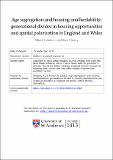Files in this item
Age segregation and housing unaffordability : generational divides in housing opportunities and spatial polarisation in England and Wales
Item metadata
| dc.contributor.author | Sabater, Albert | |
| dc.contributor.author | Finney, Nissa | |
| dc.date.accessioned | 2022-10-05T14:30:09Z | |
| dc.date.available | 2022-10-05T14:30:09Z | |
| dc.date.issued | 2023-04-01 | |
| dc.identifier | 281323186 | |
| dc.identifier | c4cf4acd-e4d4-4f07-a3a9-989dfdb7a90a | |
| dc.identifier | 85139090981 | |
| dc.identifier | 000890629100001 | |
| dc.identifier.citation | Sabater , A & Finney , N 2023 , ' Age segregation and housing unaffordability : generational divides in housing opportunities and spatial polarisation in England and Wales ' , Urban Studies , vol. 60 , no. 5 , pp. 941-961 . https://doi.org/10.1177/00420980221121088 | en |
| dc.identifier.issn | 0042-0980 | |
| dc.identifier.other | ORCID: /0000-0001-6602-9920/work/120434334 | |
| dc.identifier.uri | https://hdl.handle.net/10023/26138 | |
| dc.description | Funding: This work was carried out with partial financial support from the Economic and Social Research Council through the ESRC Centre for Population Change under grant ES/R009139/1. | en |
| dc.description.abstract | Age is an important known driver of residential sorting, yet little is understood about how age segregation is affected by housing unaffordability. This relationship is particularly pertinent given trends of increasing housing inequalities and population ageing, in Europe and elsewhere. Using harmonised population data for small areas linked with local house price statistics and household incomes in England and Wales, this paper examines the scale of, and links between, residential age segregation and housing unaffordability. The results reveal a strong association between increasing housing unaffordability (for sales and rentals) and increasing residential age segregation (beyond other local characteristics). This association is particularly marked in urban and rich (least deprived) areas. This points to increasing spatial polarisation along the intersections of wealth and age: not only are the wealthiest parts of the country, where housing is particularly unaffordable, becoming increasingly demarcated socio-economically but also by age. This implies that age-related lifecourse processes are integral to the trends observed more broadly of increasing socio-spatial polarisation. | |
| dc.format.extent | 21 | |
| dc.format.extent | 778442 | |
| dc.language.iso | eng | |
| dc.relation.ispartof | Urban Studies | en |
| dc.subject | Residential age segregation | en |
| dc.subject | Housing unaffordability | en |
| dc.subject | Intergenerational fairness | en |
| dc.subject | Socio-spatial inequalities | en |
| dc.subject | Spatial polarisation | en |
| dc.subject | England and Wales | en |
| dc.subject | GF Human ecology. Anthropogeography | en |
| dc.subject | 3rd-DAS | en |
| dc.subject | SDG 11 - Sustainable Cities and Communities | en |
| dc.subject | MCC | en |
| dc.subject.lcc | GF | en |
| dc.title | Age segregation and housing unaffordability : generational divides in housing opportunities and spatial polarisation in England and Wales | en |
| dc.type | Journal article | en |
| dc.contributor.sponsor | Economic & Social Research Council | en |
| dc.contributor.institution | University of St Andrews. School of Geography & Sustainable Development | en |
| dc.contributor.institution | University of St Andrews. Centre for Minorities Research (CMR) | en |
| dc.contributor.institution | University of St Andrews. Population and Health Research | en |
| dc.contributor.institution | University of St Andrews. Geographies of Sustainability, Society, Inequalities and Possibilities | en |
| dc.identifier.doi | 10.1177/00420980221121088 | |
| dc.description.status | Peer reviewed | en |
| dc.identifier.grantnumber | ES/R009139/1 | en |
This item appears in the following Collection(s)
Items in the St Andrews Research Repository are protected by copyright, with all rights reserved, unless otherwise indicated.

